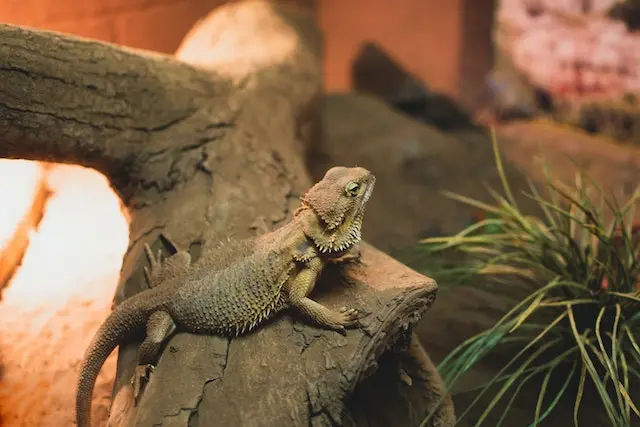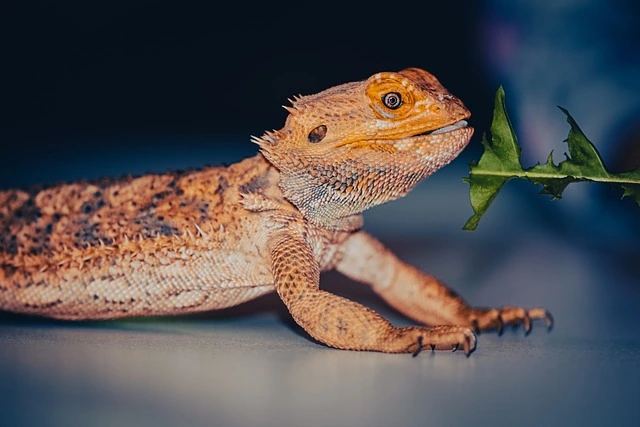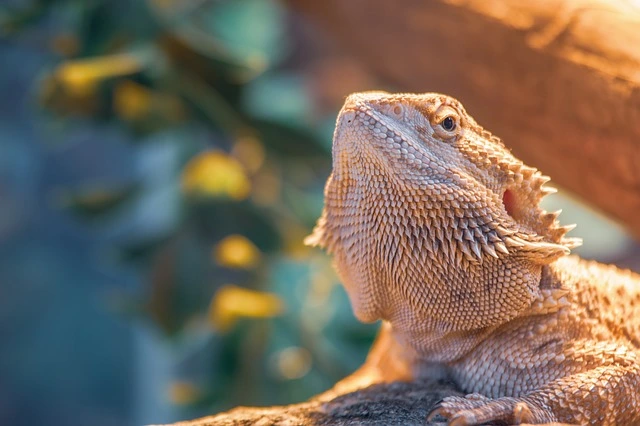Bearded dragons, affectionately known as “Beardies,” are a popular choice for reptile enthusiasts, valued for their amiable disposition and adaptability to captivity. Originating from the diverse landscapes of Australia, these lizards are often found basking under the sun or climbing trees. Their unique behaviour of opening their mouths, often mistaken for a smile, is actually a thermoregulation technique to keep cool in their hot habitat.
In captivity, bearded dragons display a remarkable tolerance for handling, making them a favoured choice among beginners and experienced reptile keepers alike. Their diet mainly consists of leafy greens and insects, showcasing their omnivorous nature. As intelligent and sociable creatures, they thrive in an environment that offers a balance of warmth, nutrition, and interaction.
This guide delves into the fascinating world of bearded dragons, offering insights into their care, habitat requirements, and overall well-being.

General Overview
| Information | Description |
|---|---|
| Common name | Bearded dragon |
| Size | 24 inches (60cm) |
| Recommended keepers | Beginner to imtermediate |
| Native region | Australia |
| Habitat | Forested, semi-desert areas |
| Lifespan | 7-12 years |
| Diet | Omnivores (plants and insects) |
| Enclosure | Glass or wood, minumum 183x61x61 cm, recommended 183x61x91 cm (72’x24’x35′) |
| Popular alteranatives | Blue-Tongued Skink, Leopard Gecko, Crested Gecko |
Keeping Bearded Dragon as a Pet
If you’re considering a bearded dragon as a pet, there are several essential factors to keep in mind to ensure their well-being and happiness.
First and foremost, you must provide a suitable habitat that mimics their natural environment. This should include a basking area with a heat source, a shaded area to retreat, and a substrate that allows for burrowing. It’s crucial to maintain a consistent temperature and humidity level in their enclosure, and provide access to clean water and a varied diet of leafy greens and insects.
Bearded dragons are highly sociable and intelligent creatures, so providing regular interaction and stimulation is vital. This includes daily handling and opportunities for exercise and exploration, such as providing rocks, branches, and tunnels to climb and explore.
Regular veterinary check-ups are also crucial to ensure your pet’s health and identify any potential health issues early. As with any pet, providing a safe, loving, and comfortable environment is key to a happy and healthy life.
To provide the best environment for your beardie, put the following items on your shopping list:
- Enclosure (glass or wood) – Recommendations in our dedicated guide
- Basking light or ceramic heat emitter
- UBV bulb
- Heat mat
- Large water bow
- Feeding bow
- Supplements
- Decorative rocks, branches

Vivarium Requirements for Bearded Dragons
A bearded dragon’s vivarium is more than just a housing space; it’s a replication of their natural environment. The ideal vivarium for an adult bearded dragon should measure at least 183 cm in length, 61 cm in width, and 61 cm in height, with larger enclosures being highly recommended for optimal comfort. Options for vivarium materials include glass, plastic, or wood, each offering its own set of benefits.
We have a dedicated guide on how to choose a vivarium for a bearded dragon, including size and product recommendations.
When setting up the vivarium, it’s essential to create distinct zones within the enclosure. This includes a basking area equipped with a reliable heat source and a shaded area for cooling down.
Temperature Requirements
Bearded dragons require a carefully controlled thermal environment to mimic their natural Australian habitat. The vivarium should have a basking zone where temperatures range between 38-42°C, allowing them to bask under the warmth as they would in the wild. The cooler end of the vivarium should be maintained at a comfortable 22-26°C. This temperature gradient is crucial for their health, enabling them to thermoregulate effectively.
Some bearded dragons enjoy basking in the natural sunlight outside, but caution must be exercised, and they should be supervised at all times to ensure their safety.
In general, these creatures require high temperatures and relatively low humidity to thrive. It’s essential to be mindful of any changes in their behavior, as excessive “smiling” or mouth-opening may indicate that the enclosure is too hot.
Lighting Inside the Bearded Dragon Vivarium
For lighting, these diurnal reptiles need a cycle of 12 hours of daylight and 12 hours of darkness to regulate their circadian rhythms. High-output UVB fluorescent lighting is essential, as it plays a vital role in their health, aiding in calcium absorption and preventing metabolic bone diseases. The UVB light should be positioned near the basking area, maintaining a UV index between 3.0-5.0. Regular replacement of UVB bulbs ensures consistent and effective lighting.
Water and Humidity
Just because they are desert animals doesn’t mean they don’t like to drink water. On the contrary, bearded dragons love to take baths and for this it is advisable to have a large enough bowl in which they can lie down and soak whenever they wish.
Beardies thrive in a humidity range of 30%-40%. It’s essential to note that specific humidity and temperature levels may vary depending on the geographic location and the species of bearded dragon you have in captivity (more on that below).
Substrate for Brearded Dragons Vivarium
A good substrate should mimic a bearded dragon’s natural environment in Australia. They should be burrowable, so your dragon can dig to its heart’s content. As long as you do your research, not be afraid to use “loose” substrates. Substrates composed of natural materials do not often pose an impaction risk, as bearded dragon’s digestive tracts are built to handle. Pack the substrate 4-6″ deep for best results.
| Good substrate | Bad substate |
| Zoo Med ReptiSand® | Calcium sand — can lead to impaction due to presence of calcium carbonate |
| Exo Terra Desert Sand | Vitamin sand – can lead to impaction due to presence of calcium carbonate |
| Zoo Med Excavator Clay Burrowing Substrate | Ground nut shell — dusty; can cause impaction |
| DIY option — 50% sand (preferably very fine), 30% organic topsoil, 20% Zoo Med Excavator Clay | Linoleum — produces VOCs (Volatile Organic Compounds) |
Can Sand Cause Impaction in Bearded dragons?
In the realm of bearded dragon substrate, sand is a hotly debated topic. While some husbandry sources denounce sand as unsuitable, it can actually be a stimulating and visually pleasing part of your pet’s enclosure when used correctly. That being said, there are some risks to be aware of and precautions to take:
- Dust can be mitigated by opting for high-quality sand. Play sand, in particular, tends to be quite dusty.
- Dyed sand is easy to spot – if the color appears unnatural (e.g. green, pink, blue), it’s probably dyed and may stain your dragon. Be sure to do your research on the product before purchasing.
- If your dragon is undergoing medical treatment that involves ointment, sand may stick to it. In this case, it’s best to either remove the sand or lay a different substrate over it until treatment is complete. Tile and flagstone can serve as temporary, immovable substrates.
Bearded Dragon Diet and Nutrition
In the wild, bearded dragons are omnivores, feeding on a mix of insects, small rodents, and vegetation. In captivity, their diet should consist of leafy greens, vegetables, and insects. Juveniles require more frequent feedings with a higher percentage of protein, while adults can be fed less often with a focus on plant-based foods. A typical diet for an adult bearded dragon should include greens like collard and mustard greens, supplemented with insects like crickets and superworms.
Supplements are crucial in a captive diet to ensure they receive all necessary nutrients. Calcium and Vitamin D3 supplements should be incorporated into their meals to support bone health and overall well-being. Water availability is also essential; a shallow water dish should always be present in the vivarium for hydration.
Read our dedicate guide with diet recommendations here. You will find a list of suitable foods, as well as one with what to avoid.
Feeding Young Bearded Dragons
As juveniles, young Bearded Dragons require a balanced diet of leafy greens and insects, with greens every day and insects every other day. In their adult stage, they should be fed daily, mostly with crickets and lots of green vegetables like collard greens and mustard greens. It’s also important to incorporate calcium and Vitamin D3 supplements into their food to keep them healthy.
When to Feed a Bearded Dragon
Remember, the best time of day to feed your dragon is in the morning, allowing them to digest their food during the warmest part of the day.

Health and Well-being
As with all living beings, Bearded Dragons have a finite lifespan, generally living between 7 and 12 years in captivity.
Bearded dragons are robust reptiles, but they require attentive care to prevent health issues. Regular veterinary check-ups are vital for early detection and treatment of common health problems like metabolic bone disease, often caused by inadequate UVB exposure or calcium deficiency. Be aware of behavioral changes such as lethargy, loss of appetite, or excessive basking, as these can be signs of health issues or stress.
Shedding and brumation are natural processes for bearded dragons. Shedding occurs regularly as they grow, and providing rough surfaces can aid in this process. Brumation, a form of hibernation, may occur in colder months, during which they become less active and eat less. Understanding and accommodating these natural behaviors are key to their well-being.
Habitat Decoration and Enrichment
Creating an enriching environment is crucial for the mental and physical health of bearded dragons. The vivarium should include elements like rocks, branches, and tunnels to mimic their natural habitat, providing ample opportunities for climbing and exploring. These features not only serve as decorative elements but also promote natural behaviors and physical exercise.
Live or artificial plants add to the aesthetic of the enclosure and provide hiding spots, creating a sense of security for your dragon. For those interested in bioactive setups, incorporating live plants and a dynamic ecosystem can create a more natural and self-sustaining environment.
Hydration and Water Requirements
Despite their desert origins, bearded dragons require consistent access to water. A shallow water bowl in the vivarium allows them to drink and bathe, aiding in hydration and skin health. Regular changing of the water is crucial to ensure cleanliness. Additionally, misting the enclosure can increase humidity levels, especially beneficial during shedding periods. However, it’s important to avoid overly damp conditions, as this can lead to health issues.
Breeding Bearded Dragons
For those interested in breeding, understanding the specific needs of bearded dragons during this time is crucial. This includes providing an appropriate nesting area for females to lay eggs and ensuring optimal temperature and humidity levels for egg incubation. Breeding requires careful planning and additional resources, and it’s recommended to seek advice from experienced breeders or veterinarians.
Cleaning and Maintenance of the Vivarim
Maintaining a clean and hygienic environment is crucial for the health of your bearded dragon. Regular cleaning of the vivarium includes daily spot cleaning to remove waste and uneaten food, as well as a thorough cleaning every few months. Use reptile-safe disinfectants and rinse the enclosure thoroughly after cleaning. Substrate changes should be done as needed, typically every 3-6 months, depending on the type of substrate used.

Handling and Interaction with Your Bearded Dtragon
Interacting with your bearded dragon is not just about physical handling; it’s about building a bond of trust and understanding. Approach them gently and always support their legs to make them feel secure. But it’s not just about how you pick them up; it’s about reading their mood and respecting their space. Some days they might be up for adventure and interaction, while on others, they might prefer to be left alone. Observe their behavior closely – if they back away or show signs of distress, it’s best to give them some time. Over time, you’ll learn to understand their unique personalities and preferences, deepening your connection with these fascinating creatures
Types of Bearded Dragons
In the wild, there are eight distinct breeds of bearded dragons, each with their unique characteristics and behaviors. However, not all of them are well-suited to become beloved pets, and it is essential to understand the specific requirements of your chosen species before bringing them home.
The most popular and commonly kept species of bearded dragon is the Pogona vitticeps. These remarkable creatures are renowned for their gentle and serene nature, often allowing themselves to be handled by their owners. In some instances, they may even form a strong bond with their human companions, highlighting their exceptional intelligence and sociability.
| Species Name | Adult Size | Color | Found in |
|---|---|---|---|
| Pogona barbata | 24″ / 60cm | Gray or red | Eastern Australia |
| Pogona henrylawsoni | 12″ / 30cm | Tan or yellow | Western and Central Australia |
| Pogona microlepidota | 4 -6″ / 10-15cm | Tan or red | Northern Australia |
| Pogona minor minor | 14-18″ / 35-45cm | Tan or brown | Western and Central Australia |
| Pogona minor minima | 12″ / 30cm | Tan or brown | Houtman Abrolhos Islands |
| Pogona minor mitchelli | 18″ / 45cm | Tan or red | Northwestern Australia |
| Pogona nullarbor | 14″ / 35cm | Tan or brown | Southern Australia |
| Pogona vitticeps | 24″ / 60cm | Yellow or red | Central Australia |
Nonetheless, it is important to know that as every reptile, the bearded dragon is not a cuddly animal and children should only come into contact with it under supervision.
10 fun facts about the Bearded dragon:
- Both male and female Bearded Dragons possess beards, which they inflate when threatened, making themselves appear larger and more intimidating to predators.
- Intriguingly, Bearded Dragons use non-verbal methods to communicate with each other. They engage in a captivating display of waving and head-bobbing to convey their messages.
- Bearded Dragons are natural climbers and enjoy scaling rocks and tree branches in their habitat. They have a remarkable ability to cling to rough surfaces using their sharp claws.
- Surprisingly, these captivating creatures were not introduced to the United States until around 1990. Since then, they have become a popular pet choice for reptile enthusiasts.
- At the tender age of 1-2 years, these creatures usually reach full sexual maturity and attain their maximum size.
- Their tongues are specially designed for capturing insects, much like their distant relative, the chameleon. They shoot out their sticky tongue to catch their prey with incredible accuracy.
- In addition to their keen vision, Bearded Dragons have a third (parietal) eye, located on top of their head, which can detect predators from a distance.
- These creatures have a unique ability to alter their appearance by tightening their usually soft scales into sharp spines, making them a formidable opponent against predators.
- Bearded Dragons can regulate their body temperature by darkening their color to absorb more heat, an impressive feature that allows them to thrive in their natural environment.
- Lastly, their ability to inflate their abdomen facilitates floating in deep water, an impressive feat for a land-dwelling species.
Conclusion: What We’ve Learnt About Bearded Dragon Care
Embarking on the journey of caring for a bearded dragon is both a joy and a responsibility. As we’ve explored, these remarkable creatures require a habitat that mimics their natural environment, complete with appropriate temperature gradients, UV lighting, and a habitat that promotes their well-being. Remember, the right vivarium size, lighting, and temperature are not just comforts; they are necessities for your dragon’s health.
Their diet, an interesting mix of greens and live food, should be varied and nutritionally balanced. And let’s not forget the importance of behavioral enrichment and gentle, respectful handling to ensure your dragon feels secure and stimulated.
Every bearded dragon is unique, with its own personality and preferences. By understanding and catering to these individual needs, you can ensure a fulfilling and loving relationship with your pet. Regular vet check-ups, attentive care, and a commitment to creating a safe and enriching environment will help your bearded dragon thrive.
In the end, caring for a bearded dragon is about more than just meeting their basic needs; it’s about creating a bond that enriches both your lives. With the right care, attention, and love, your bearded dragon will not just survive, but flourish, bringing a touch of the wild into your home and heart.
